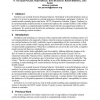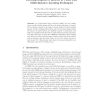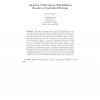E4MAS
2005
Springer
14 years 5 months ago
2005
Springer
Stigmergy (the coordination of agents through signs they make and sense in a shared environment) was originally articulated in the study of social insects. Its basic processes are ...
E4MAS
2005
Springer
14 years 5 months ago
2005
Springer
Emerging pervasive computing technologies such as sensor networks and RFID tags can be embedded in our everyday environment to digitally store and elaborate a variety of informatio...
E4MAS
2005
Springer
14 years 5 months ago
2005
Springer
Abstract. While agents and environments are two intimately connected concepts, most approaches for multi-agent development focus on the agent-specific part of the system, whereas ...
DAMAS
2005
Springer
14 years 5 months ago
2005
Springer
We present a novel cognitive agent architecture and demonstrate its effectiveness in the Sense and Respond Logistics (SRL) domain. Effective applications to support SRL must antic...
DAMAS
2005
Springer
14 years 5 months ago
2005
Springer
ct Emotion is an essential element of human behavior. Particularly in stressful situations such as combat, it is at least as important as rational analysis in determining a partici...
COGSYS
2005
Springer
14 years 5 months ago
2005
Springer
Abstract. The definition, assembly and manipulation of learning objects is becoming more and more popular in learning environments. But despite standardization efforts their approp...
AUSAI
2005
Springer
14 years 5 months ago
2005
Springer
SuperParent-One-Dependence Estimators (SPODEs) loosen Naive-Bayes’ attribute independence assumption by allowing each attribute to depend on a common single attribute (superpare...
AUSAI
2005
Springer
14 years 5 months ago
2005
Springer
In content-based image retrieval (CBIR), the user usually poses several labelled images and then the system attempts to retrieve all the images relevant to the target concept defi...
AUSAI
2005
Springer
14 years 5 months ago
2005
Springer
Most data-mining techniques seek a single model that optimizes an objective function with respect to the data. In many real-world applications several models will equally optimize...
AUSAI
2005
Springer
14 years 5 months ago
2005
Springer
This paper addresses the problem of scheduling jobs in soft real-time systems, where the utility of completing each job decreases over time. We present a utility-based framework fo...



